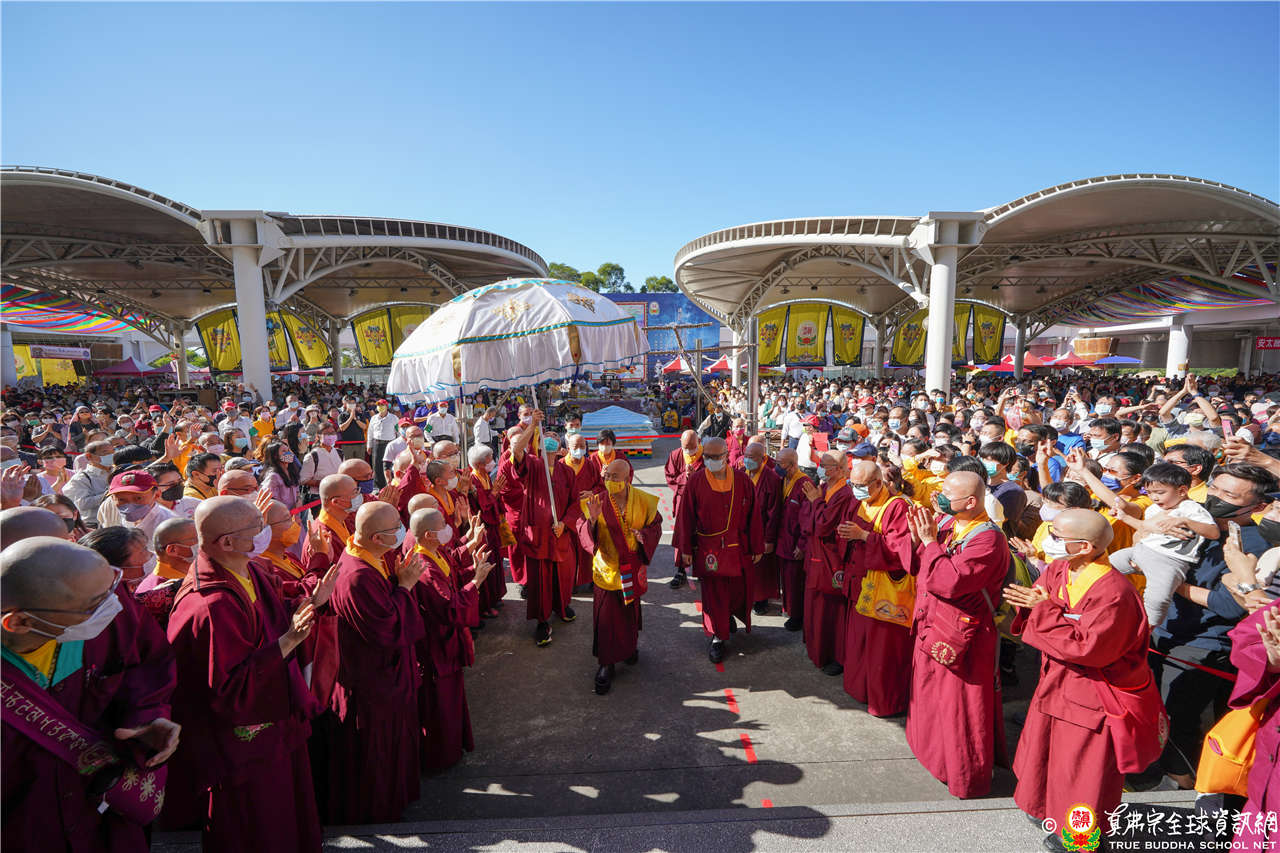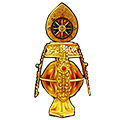
Vimalakirti Nirdesa Sutra
A Detailed Exposition by Living Buddha Lian Sheng, Grandmaster Sheng-Yen Lu
Translated into English by the True Buddha School Vimala Sutra Translation Team
Discourse 52, 3 December 2022 - Chapter One—Buddhaverse (Continued)
Chapter One—Buddhaverse
Also, there were tens of thousands of Mahabrahma Sikhin and other devas from the rest of the Four Heavens descending to the Buddha’s place to listen to the dharma. In the assembly, there were also twelve thousand celestial kings, the mighty heavenly beings, dragon gods, yaksas, gandharvas, asuras, garudas, kinnaras, maharagas, as well as all the bhiksus, bhiksunis, upasakas, and upasikas.
Let’s now talk about the Vimalakirti Sutra. I have completed my exposition on the 52 bodhisattvas at the Seattle Leizang Temple and the Rainbow Temple. These 52 bodhisattvas were not the only ones in attendance. There were a total of 32,000 bodhisattvas. In addition, there were also tens of thousands of Mahabrahma Sikhin. Sikhin is the name of a Brahma Deva. One of the seven buddhas is also called Sikhin.
So, there were tens of thousands of Mahabrahma Devas. The Brahman Heaven is at the first level of the Heavenly Realm of Form, and its king is called Mahabrahma Deva. Do you know how long the lifespan of Mahabrahma is? As I have said before, ten kalpas. One kalpa is the length of time the saha world takes to be created, exist, deteriorate, and be extinct. It is the time from creation to annihilation of the saha world. His lifespan equals ten kalpas, meaning ten times the creations and annihilations of the saha world. Mahabrahma alone has such a long lifespan. Think about how big the world is and how long this is. By comparison, the human lifespan would be as if one were born in the morning and dead by the evening. And there were a great number of Mahabrahma Devas: Sikhin and such.
…and other devas from the rest of the Four Heavens...
Under the Four Heavens are the four continents of Purvavideha to the east, Jambudvipa to the south, Aparagodaniya to the west, and Uttarakuruto the north. In Buddhist cosmology, Mount Meru is at the center and is surrounded by these four major continents, along with eight subcontinents. The saha world we live in is in the southern continent called Jambudvipa.
Remember the Monkey King? According to Wu Chengen’s Journey to the West, the Monkey King was a piece of rock from the Flowers and Fruit Mountain in the country of Aolai, in Purvavideha. So, he was from Purvavideha of the east, while our saha world lies at Jambudvipa in the south.
…descending to the Buddha’s place to listen to the dharma.
All beings came to the saha world to listen to Sakyamuni Buddha expounding the dharma. From the Four Heavens, there were also twelve thousand celestial kings. Do you know what a celestial king is? What we call the Jade Emperor in Taiwan is a celestial king. Sakra Devanam Indra, or simply known as Indra, is also a celestial king. In Buddhism, he is the king of the Trayastrimsa Heaven (Thirty-third Heaven) at the peak and center of Mount Meru. There are eight heavens on each of the four sides of Mount Meru, totaling thirty-two, as well as one heaven at the center peak. Thus altogether, there are thirty-three heavens and thirty-three heavenly kings. Indra is the king at the center. Besides him, there are thirty-two other kings. However, the world is huge, and there are many Mount Merus. That’s why there were as many as twelve thousand celestial kings descended and sat together.
Talking about the celestial king (tiandi), did you know that there is a Tiandi Sect (The Church of the Lord of the Universe) in Taiwan? Is anyone here its follower? Please raise your hand if you are. If you believe in Tiandi, it means you believe in Indra. Of course, you can follow a celestial king since a celestial king has heavenly great fortune. Such a sect is a religion of blessings.
Do you know the origin of this sect? Perhaps you do because I have mentioned it before. Back then, I had just started and was still living in Taiwan. The founder, Li Yujie, first went to the Tiande Sect (Holy Church of the Heavenly Virtue), headed by Huang Depu, who was also the Minister of the Interior Department back then. Li was a long-term disciple of Teacher Xiao Changming from Mount Hua, China. The Patriarch Xiao Changming and his son founded the Tiande Sect and its twenty-character mantra. At that time, its abbots were Huang Depu and General Huang Jie, the governor of Taiwan province—also known as Wu Xingzhen.
Li once invited me for dinner at the Leofoo Hotel; several disciples also went—Master Lian Huo and Master Lian Shi. Anyone else? Does the Leofoo Hotel still exist? Not anymore? Oh, so it no longer exists. At the Leofoo Hotel, Li consulted me and said, “I also want to establish a sect. Grandmaster Lu, please help me select a name.” I gave it the name “Tiandi Sect.” So Tiandiism is a sect that I named, as requested by Li Yujie.
Interestingly, some [True Buddha] disciples went to this Tiandi Sect and took refuge there. Oh well, it is all fine because the name was given by Grandmaster, after all. They advocate the twenty [Chinese] character mantra: loyalty, forgiveness, integrity, brightness, ethics, uprightness, righteousness, trust, forbearance, impartiality, broadness, filial piety, benevolence, mercifulness, consciousness, temperance, frugality, genuineness, propriety, and harmony. I gave the name of this sect, so if you follow Tiandi Sect, it is the same as following me.
Twelve thousand celestial kings descended from the Four Heavens to listen to Sakyamuni Buddha’s dharma teaching. In addition, there were mighty heavenly beings, dragon gods, yaksas, gandharvas, asuras, garudas, kinnaras, and maharagas, who altogether make up the Eight Divisions of Gods and Dragons.
Nagas or dragons are part of the eightfold pantheons. Yaksas can move and fly very fast and belong to the category of ghosts. Gandharvas are the musicians of the celestial kings. Asuras are also one of the eightfold pantheons. They cultivated and gained heavenly merit; they enjoy great fortune, but their anger and aggression are strong, and they are prone to fight. So, gods (or demigods) who love to fight and get into conflicts are called asuras.
There were also garudas, the great golden-winged birds. There is an Indonesian airline called Garuda. [Garuda is mentioned in the offering verse to the ghosts and gods.] “To the great golden-winged garuda birds, the multitude of ghosts and gods in the desolate wilderness, yaksas, ghost mothers, and all their children, may you all be filled with sweet dew.”
Kinnaras are often mentioned in the Buddhist sutras. They look human, but they are not human. What kind of human is Grandmaster? He is an avatar who is half god and half human, like in the [Disney’s Avatar] movie. But kinnaras are not avatars; they are not humans but look like humans. They have a horn on their head and look very ugly. Have you seen them? No? Grandmaster has seen them. Nonetheless, their voice is fabulous! Their singing is number one—the very best! I learned a song from them, a lullaby I sing for children when I want to charm them. Can you sing it? [Singing] That lullaby was taught by the kinnaras.
Maharagas also came. Maharagas, one of the eightfold pantheons, have the body of a giant serpent. Even as a snake, they are considered gods. So, all of the Eight Divisions of Gods and Dragons: the heavenly beings, dragon gods, yaksas, gandharvas, asuras, garudas, kinnaras, and maharagas were all present in the assembly. These are gods and spirits with mighty powers, and they all came to attend Sakyamuni Buddha’s dharma assembly. The ceremony was fantastic, and everyone was very pleased.
This is my first ceremony on the treasure island of Taiwan. May this beginning be auspicious and may the dharma teaching go well. May it bring tremendous benefits to the listeners. I wish all True Buddha School disciples good health, all wishes fulfilled, and may they be diligent in their spiritual cultivation and dharma practices. May everyone reach attainment. Thank you, everyone.
Om mani padme hum.
Next discourse on the Vimalakirti Sutra: Discourse 53, 10 December 2022 - Chapter One—Buddhaverse (Continued)
Previous discourse on the Vimalakirti Sutra: Discourse 51, 13 November 2022 - Chapter One—Buddhaverse (Continued)
Index of links to all discourse on the Vimalakirti Sutra: https://en.tbsn.org/guidem/detail/2975/
Back to the main index page of all dharma discourse: https://en.tbsn.org/guidem/index
Full webcast of 2022.12.3 Golden Mother Homa Ceremony (Taiwan Lei Tsang Temple) and dharma discourse with English interpretation: https://youtu.be/YNAdf1Oj9Hs




